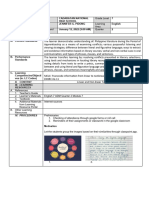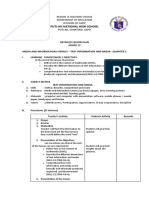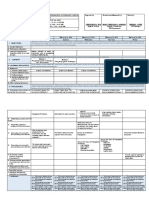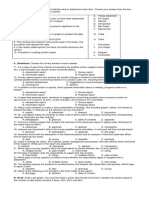Dlp-Cot2a MIL
Uploaded by
Maann KatJacobDlp-Cot2a MIL
Uploaded by
Maann KatJacobGRADES 11 School Grade Level Grade 12
DAILY
Teacher Learning Area Media and Information Literacy (MIL)
LESSON
PLAN Teaching Dates Semester 2nd
I. Objectives
A. Content Standard The learners demonstrate understanding of different resources of media and information, their design principle and elements, and selection
criteria.
B. Performance Standard The learners produce a living museum or electronic portfolio or any other creative forms of multimedia showcasing their/his/her
understanding, insights and perceptions of the different resources of media and information.
C. Learning Describes the different dimensions of visual information media.
Competencies Comprehends how visual information and media is/are formally and formally produced, organized and disseminated
MIL11/12MIM-IVc-8
D. Specific Objectives At the end of the session, the students will be able to:
1. Demonstrate an understanding of motion media and information and gain comprehensive knowledge on how to effectively evaluate them.
2. Produce an motion-based text presentation anchored on design principles and elements.
3. Evaluate the design principles of motion media and information revolve using design principle elements.
II. Content ssss
III. Learning Resources: ssss
IV. Pedagogical Integrative Approach
Approach & Strategy Scaffold-Knowledge Integration
used 4 A’s
V. Procedure: Daily Routine (5 min)
Checking of Attendances
Greetings
Putting the class in order
Simple recall of previous lesson
A. Motivation: Short Video Presentation – The Life Cycle of the Butterfly (Integration across the curriculum)
1. Understanding and applying motion media and information that revolves around design principle elements.
2. Demonstrating crictical and creative thinking skills in arts.
B. Lesson Proper: ACT: Tapping into prior knowledge (Integration within the curriculum)
The teacher will bring the learners to a focus by showing an example of a flipbook and discuss what is flipbook. Questions will be given and
volunteer students will be called anwer.
Do you have any idea about animation?
Have you ever create/drawn a picture and then made it come alive?
After, the teacher will explain what is the connection of flipbook to the lsson.And also, will instruct students to bring out all the materials
needed (finished storyboard and drawings in previous lesson).
For processing, students will be given a time and with the same groupings, they will create a motion media by making flipbook.
ANALYZE (Collaboration with students)
To analyze, each group will be given a chance to evaluate the work of other two groups. They will provide a rubrics that describes the
motion media design principle elements. And the teacher will summarize the answers in provided rubric.
ABSTRACTION
The teacher will make a generalization to the topic.
For processing,students will anwer the questions given and they will internalize the significance of motion media
Did you find the activity (making flipbook) interesting?
Did you find motion media valuable in your lives?In what ways?
C. Deepening: SCIENCE (Integration across the curriculum)
The lesson is related to the life cycle of a butterfly, showing the example of a simple motion and let the students create to show the starting
and end position of the object.
ARTS (Integration across the curriculum –specifically Animation)
Creating flipbook is a simple form of animation consisting of series of drawings.In relation to the topic, the images appear to animate by
simulating motion.
After the “posting” of responses, students watch a short video presentation on Animation. Sharing of insights.
D. Application:
APPLICATION: Making Flipbook ( Integration within curriculum)
The class will group into 3 groups, they will work independently and instruct how to do it.
1. Bring out the materials needed. ( Storyboard, drawings, paste, coloring materials, pens,etc.)
2. Make a stack of paper and bind it using glue or staples or a paper clip.
3. Paste your drawing left aligned as a starting point.
4. On the next sheet of paper, not in the same spot. See to it the second sequence should display minor shift from the first image.
5. Use coloring pens and materials to make it more interesting.
6. Flip through your flipbook to watch your animation once it is finished, be sure they are not sticking together.
D. Synthesis: Representatives from each group will be called to share their answers. Processing of responses in class will follow.
E. Evaluation: 1. The action or process of moving or being moved?
a. Motion
b. Animation
c. Media
d. Acting
2. A design principle that works by adjusting the frame in order to give the impression of something moving slowly then rapidly.
a. Timing
b. Anticipation
c. Staging
d. Ease in/out
V. Remarks: Flip books are often illustrated books for children, but may also be geared towards adults and employ a series of photographs rather than
drawings.
Literacy skills are honed through the various readings and interpretations done in class, through the Storyboard of “The Life Cycle of
Butterfly”
Numeracy skills are targeted in the discussion of figures presented through the video in Animation.
Engaging learners in various tasks in succession allow management of learners inside the classroom, their physical learning
environment.
Group tasks: answering different questions allow for diversity of learners. Shy or passive students will be given a chance to voice out or
express themselves. Groupings which were done heterogeneously, considered the learners’ genders, needs, strengths, interests, &
experiences.
The use of Constructivism and PAR (Present-Apply-Review) Model allowed the developmental sequencing of the lesson.
Finally, since the lesson focused on textual analysis, it will contribute to the achievement of both the Content and Performance standards
for the quarter.
VI. Reflection:
Prepared by: Checked by: Noted by:
You might also like
- Hourglass Workout Program by Luisagiuliet 276% (21)Hourglass Workout Program by Luisagiuliet 251 pages
- Read People Like A Book by Patrick King-Edited57% (82)Read People Like A Book by Patrick King-Edited12 pages
- Livingood, Blake - Livingood Daily Your 21-Day Guide To Experience Real Health77% (13)Livingood, Blake - Livingood Daily Your 21-Day Guide To Experience Real Health260 pages
- Donald Trump & Jeffrey Epstein Rape Lawsuit and Affidavits83% (1016)Donald Trump & Jeffrey Epstein Rape Lawsuit and Affidavits13 pages
- The 36 Questions That Lead To Love - The New York Times94% (34)The 36 Questions That Lead To Love - The New York Times3 pages
- The 36 Questions That Lead To Love - The New York Times95% (21)The 36 Questions That Lead To Love - The New York Times3 pages
- Jeffrey Epstein39s Little Black Book Unredacted PDF75% (12)Jeffrey Epstein39s Little Black Book Unredacted PDF95 pages
- 14 Easiest & Hardest Muscles To Build (Ranked With Solutions)100% (8)14 Easiest & Hardest Muscles To Build (Ranked With Solutions)27 pages
- The 4 Hour Workweek, Expanded and Updated by Timothy Ferriss - Excerpt23% (954)The 4 Hour Workweek, Expanded and Updated by Timothy Ferriss - Excerpt38 pages
- Argument Writing Parts of An Argument 2 PDF100% (1)Argument Writing Parts of An Argument 2 PDF1 page
- Republic of The Philippines Division of Laguna School Year 2016-2017No ratings yetRepublic of The Philippines Division of Laguna School Year 2016-20178 pages
- Expressing and Developing Ideas in Visual Texts Interacting and Relating With Others Through Visual Texts100% (1)Expressing and Developing Ideas in Visual Texts Interacting and Relating With Others Through Visual Texts3 pages
- School Grade Level Teacher Learning Area Teaching Date and Time Quarter Teaching Modality No. of Days I. ObjectivesNo ratings yetSchool Grade Level Teacher Learning Area Teaching Date and Time Quarter Teaching Modality No. of Days I. Objectives6 pages
- English G8 Using Information Maps in Note TakingNo ratings yetEnglish G8 Using Information Maps in Note Taking34 pages
- Organizing Information Using Graphic Organizer GRADE 8No ratings yetOrganizing Information Using Graphic Organizer GRADE 830 pages
- Media and Information Literacy Daily Lesson LogNo ratings yetMedia and Information Literacy Daily Lesson Log3 pages
- I. Objectives A. Content Standards: Mandurriao National High School Lesson Plan For English Grade 10No ratings yetI. Objectives A. Content Standards: Mandurriao National High School Lesson Plan For English Grade 105 pages
- 2 English 8 q1 Mod2 Writing Bibliography Final 07282020100% (1)2 English 8 q1 Mod2 Writing Bibliography Final 0728202033 pages
- Language of Research Campaign and AdvocacyNo ratings yetLanguage of Research Campaign and Advocacy8 pages
- DLP 15 - Reacting To Lay Value of Judgement On Critical IssuesNo ratings yetDLP 15 - Reacting To Lay Value of Judgement On Critical Issues5 pages
- #Stemtokperiments - Transforming Tiktok Into Science Edtech ToolNo ratings yet#Stemtokperiments - Transforming Tiktok Into Science Edtech Tool8 pages
- Weekly Home Learning Plan For Grade 8 Quarter 2 Week & Date Learning Area Learning Competency Learning Tasks Mode of Delivery EnglishNo ratings yetWeekly Home Learning Plan For Grade 8 Quarter 2 Week & Date Learning Area Learning Competency Learning Tasks Mode of Delivery English2 pages
- ADONIRAM JUAREZ FAMERONAG - ENGLISH 8 Detailed LPNo ratings yetADONIRAM JUAREZ FAMERONAG - ENGLISH 8 Detailed LP8 pages
- I.Objectives: Grades 1 To 12 Daily Lesson Log School Grade Level Teacher Learning Area Teaching Dates and Time QuarterNo ratings yetI.Objectives: Grades 1 To 12 Daily Lesson Log School Grade Level Teacher Learning Area Teaching Dates and Time Quarter3 pages
- Lesson Plan in Media and Information Literacy: (Have A Brief Description)No ratings yetLesson Plan in Media and Information Literacy: (Have A Brief Description)7 pages
- FIRST QUARTERLY EXAMINATION in English For Academic and Professional PurposesNo ratings yetFIRST QUARTERLY EXAMINATION in English For Academic and Professional Purposes6 pages
- Memo Format Example: Rationale For Van (Informative Heading.)No ratings yetMemo Format Example: Rationale For Van (Informative Heading.)1 page
- How To Write An Effective Argument Essay: Pre-Writing: M. ReyesNo ratings yetHow To Write An Effective Argument Essay: Pre-Writing: M. Reyes71 pages
- Position Papers: Global Classrooms 2012 Tercero ANo ratings yetPosition Papers: Global Classrooms 2012 Tercero A13 pages
- LLMD Module1-Intro To Materials Development100% (1)LLMD Module1-Intro To Materials Development23 pages
- Lesson Plan Template: Date Subject Number of Students Grade50% (2)Lesson Plan Template: Date Subject Number of Students Grade3 pages
- 2012 2013 Lifelong Learning Assessment Rubric100% (2)2012 2013 Lifelong Learning Assessment Rubric2 pages
- Ed 107 - Technology For Teaching and LearningNo ratings yetEd 107 - Technology For Teaching and Learning1 page
- Lesson Plan Framework Mathematics Secondary Pre Calc 11No ratings yetLesson Plan Framework Mathematics Secondary Pre Calc 113 pages
- Week 3 Case Study Team 1 Assignment Alexis Bollin Sandra Rogel Ana Alfaro-Garcia Reham AlkhateebNo ratings yetWeek 3 Case Study Team 1 Assignment Alexis Bollin Sandra Rogel Ana Alfaro-Garcia Reham Alkhateeb5 pages























































































































